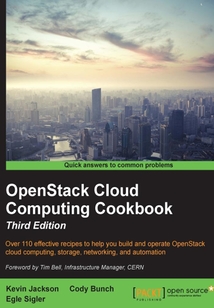舉報 

會員
OpenStack Cloud Computing Cookbook(Third Edition)
最新章節:
Index
OpenStackOpenSourcesoftwareisoneofthemostusedcloudinfrastructurestosupportsoftwaredevelopmentandbigdataanalysis.Itisdevelopedbyathrivingcommunityofindividualdevelopersfromaroundtheglobeandbackedbymostoftheleadingplayersinthecloudspacetoday.Itissimpletoimplement,massivelyscalable,andcanstorealargepoolofdataandnetworkingresources.OpenStackhasastrongecosystemthathelpsyouprovisionyourcloudstorageneeds.AddOpenStack'senterprisefeaturestoreducethecostofyourbusiness.Thisbookwillshowyouthestepstobuildupaprivatecloudenvironment.Atthebeginning,you'lldiscovertheusesofcloudservicessuchastheidentityservice,imageservice,andcomputeservice.You'lldiveintoNeutron,theOpenStackNetworkingservice,andgetyourhandsdirtywithconfiguringML2,networks,routers,andDistributedVirtualRouters.You’llthengathermoreexpertknowledgeonOpenStackcloudcomputingbymanagingyourcloud'ssecurityandmigration.Afterthat,wedelveintoOpenStackObjectstorageandhowtomanageserversandworkwithobjects,cluster,andstoragefunctionalities.Also,asyougodeeperintotherealmofOpenStack,you'lllearnpracticalexamplesofBlockstorage,LBaaS,andFWaaS:installationandconfigurationcoveredgroundup.Finally,youwilllearnOpenStackdashboard,AnsibleandForeman,Keystone,andotherinterestingtopics.
目錄(151章)
倒序
- coverpage
- OpenStack Cloud Computing Cookbook Third Edition
- Credits
- Foreword
- About the Authors
- About the Reviewers
- www.PacktPub.com
- Support files eBooks discount offers and more
- Preface
- What this book covers
- What you need for this book
- Who this book is for
- Conventions
- Reader feedback
- Customer support
- Chapter 1. Keystone – OpenStack Identity Service
- Introduction
- Installing the OpenStack Identity Service
- Configuring OpenStack Identity for SSL communication
- Creating tenants in Keystone
- Configuring roles in Keystone
- Adding users to Keystone
- Defining service endpoints
- Creating the service tenant and service users
- Configuring OpenStack Identity for LDAP Integration
- Chapter 2. Glance – OpenStack Image Service
- Introduction
- Installing OpenStack Image Service
- Configuring OpenStack Image Service with OpenStack Identity Service
- Configuring OpenStack Image Service with OpenStack Object Storage
- Managing images with OpenStack Image Service
- Registering a remotely stored image
- Sharing images among tenants
- Viewing shared images
- Using image metadata
- Migrating a VMware image
- Creating an OpenStack image
- Chapter 3. Neutron – OpenStack Networking
- Introduction
- Installing Neutron and Open vSwitch on a dedicated network node
- Configuring Neutron and Open vSwitch
- Installing and configuring the Neutron API service
- Creating a tenant Neutron network
- Deleting a Neutron network
- Creating an external floating IP Neutron network
- Using Neutron networks for different purposes
- Configuring Distributed Virtual Routers
- Using Distributed Virtual Routers
- Chapter 4. Nova – OpenStack Compute
- Introduction
- Installing OpenStack Compute controller services
- Installing OpenStack Compute packages
- Configuring database services
- Configuring OpenStack Compute
- Configuring OpenStack Compute with OpenStack Identity Service
- Stopping and starting nova services
- Installation of command-line tools on Ubuntu
- Using the command-line tools with HTTPS
- Checking OpenStack Compute services
- Using OpenStack Compute
- Managing security groups
- Creating and managing key pairs
- Launching our first cloud instance
- Fixing a broken instance deployment
- Terminating your instances
- Using live migration
- Working with nova-schedulers
- Creating flavors
- Defining host aggregates
- Launching instances in specific Availability Zones
- Launching instances on specific Compute hosts
- Removing Nova nodes from a cluster
- Chapter 5. Swift – OpenStack Object Storage
- Introduction
- Configuring Swift services and users in Keystone
- Installing OpenStack Object Storage services – proxy server
- Configuring OpenStack Object Storage – proxy server
- Installing OpenStack Object Storage services – storage nodes
- Configuring physical storage for use with Swift
- Configuring Object Storage replication
- Configuring OpenStack Object Storage – storage services
- Making the Object Storage rings
- Stopping and starting OpenStack Object Storage
- Setting up SSL access
- Chapter 6. Using OpenStack Object Storage
- Introduction
- Installing the swift client tool
- Creating containers
- Uploading objects
- Uploading large objects
- Listing containers and objects
- Downloading objects
- Deleting containers and objects
- Using OpenStack Object Storage ACLs
- Using Container Synchronization between two Swift Clusters
- Chapter 7. Administering OpenStack Object Storage
- Introduction
- Managing the OpenStack Object Storage cluster with swift-init
- Checking cluster health
- Managing the Swift cluster capacity
- Removing nodes from a cluster
- Detecting and replacing failed hard drives
- Collecting usage statistics
- Chapter 8. Cinder – OpenStack Block Storage
- Introduction
- Configuring Cinder-volume services
- Configuring OpenStack Compute for Cinder-volume
- Creating volumes
- Attaching volumes to an instance
- Detaching volumes from an instance
- Deleting volumes
- Configuring third-party volume services
- Working with Cinder snapshots
- Booting from volumes
- Chapter 9. More OpenStack
- Introduction
- Using cloud-init to run post-installation commands
- Using cloud-config to run the post-installation configuration
- Installing OpenStack Telemetry
- Using OpenStack Telemetry to interrogate usage statistics
- Installing Neutron LBaaS
- Using Neutron LBaaS
- Configuring Neutron FWaaS
- Using Neutron FWaaS
- Installing the Heat OpenStack Orchestration service
- Using Heat to spin up instances
- Chapter 10. Using the OpenStack Dashboard
- Introduction
- Installing OpenStack Dashboard
- Using OpenStack Dashboard for key management
- Using OpenStack Dashboard to manage Neutron networks
- Using OpenStack Dashboard for security group management
- Using OpenStack Dashboard to launch instances
- Using OpenStack Dashboard to terminate instances
- Using OpenStack Dashboard to connect to instances using a VNC
- Using OpenStack Dashboard to add new tenants – projects
- Using OpenStack Dashboard for user management
- Using OpenStack Dashboard with LBaaS
- Using OpenStack Dashboard with OpenStack Orchestration
- Chapter 11. Production OpenStack
- Introduction
- Installing the MariaDB Galera cluster
- Configuring HA Proxy for the MariaDB Galera cluster
- Configuring HA Proxy for high availability
- Installing and configuring Pacemaker with Corosync
- Configuring OpenStack services with Pacemaker and Corosync
- Bonding network interfaces for redundancy
- Automating OpenStack installations using Ansible – host configuration
- Automating OpenStack installations using Ansible – Playbook configuration
- Automating OpenStack installations using Ansible – running Playbooks
- Index 更新時間:2021-07-16 20:39:47
推薦閱讀
- DB2 V9權威指南
- 從零開始構建企業級RAG系統
- Mastering Concurrency Programming with Java 8
- LabVIEW Graphical Programming Cookbook
- Java高并發核心編程(卷2):多線程、鎖、JMM、JUC、高并發設計模式
- AWS Serverless架構:使用AWS從傳統部署方式向Serverless架構遷移
- Vue.js快速入門與深入實戰
- Linux環境編程:從應用到內核
- 面向對象程序設計(Java版)
- 飛槳PaddlePaddle深度學習實戰
- WordPress 4.0 Site Blueprints(Second Edition)
- 軟件品質之完美管理:實戰經典
- C++程序設計
- Python Projects for Kids
- Cloud Development andDeployment with CloudBees
- Swift編程實戰:iOS應用開發實例及完整解決方案
- Mathematica Data Visualization
- Unity3D高級編程:主程手記
- 測試基地實訓指導
- Practical XMPP
- D Cookbook
- Head First Go語言程序設計
- Java并發編程實戰
- 點云庫PCL從入門到精通
- 區塊鏈智能合約安全入門
- Java程序員職場全攻略
- 實用XML應用開發技術
- 好設計,有方法:我們在搜狐做產品體驗設計
- Web前端自動化構建:Gulp、Bower和Yeoman開發指南
- Java 9 Regular Expressions

